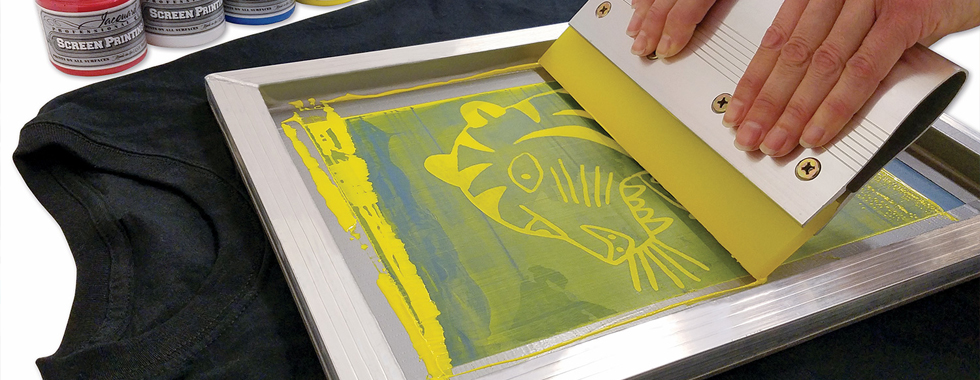ChatGPT said: Everything you need to know about reaching 10:9 Design contact for support
The Crucial Overview to Understanding Screen Printing and Its Versatile Utilizes
Screen printing has an abundant background that goes back to old times, evolving into a sophisticated technique used across various sectors today. This overview discovers the complexities of the screen printing process, outlining its applications in home, advertising, and fashion decoration - 10:9 Design contact. Comprehending these fundamentals can open innovative potential for both imaginative and business jobs. The complying with sections will certainly expose vital tips and strategies to improve one's screen printing endeavors
The Background of Screen Printing
Although screen printing has origins that map back centuries, its advancement mirrors the technological and imaginative advancements of various societies. Coming from in ancient China, the method was originally used for embellishing fabrics and later spread to Japan, where it ended up being integral to Ukiyo-e woodblock printing. The technique changed to Europe in the 18th century, where it acquired appeal amongst artisans and industrial printers. The invention of picture solution in the 20th century revolutionized screen printing, enabling for even more intricate styles and higher performance. Artists like Andy Warhol even more thrust its popularity, utilizing the tool to develop iconic works that mixed commercialism and great art. By the late 20th century, screen printing had actually established itself as a flexible method, employed in vogue, marketing, and art. Today, it remains to advance, integrating digital innovation and broadening its applications throughout numerous sectors.
The Screen Printing Process Explained
Screen printing transforms creative visions into concrete layouts with a collection of precise steps. Originally, an image is produced and afterwards moved onto a screen, generally made from great mesh material extended over a framework. A light-sensitive emulsion is related to the screen, which is revealed to light, solidifying in locations not covered by the photo. After cleaning out the unhardened emulsion, a pattern is formed.
Next, the screen is put over the substratum, whether it be fabric, paper, or one more product. Ink is after that pushed through the open locations of the pattern making use of a squeegee, transferring the style onto the substratum below. This process can be repeated for numerous colors, needing different displays for each and every hue. Lastly, the published product is treated utilizing warmth to assure the ink sticks effectively, resulting in a sturdy, vivid design on-line.
Sorts Of Screen Printing Techniques

Additionally, specialized techniques, such as discharge screen printing, remove dye from the fabric to create softer prints, while foil screen printing applies metallic aluminum foil to achieve a glossy coating (10:9 Design Screen Printing). Each strategy provides distinct attributes, satisfying various creative needs and production scales, inevitably increasing the opportunities within the screen printing domain name
Applications of Screen Printing in Various Industries

Additionally, the signage and advertising sectors utilize screen printing for creating appealing display screens and banners. This method enables vibrant shades and intricate styles that catch focus. In electronic devices, screen printing is used for using conductive inks to motherboard, crucial for element connections. The home style industry welcomes screen printing to produce distinct designs on fabrics and wall art. Generally, screen printing serves as an essential tool throughout diverse fields, improving products with customized and visually attractive graphics.
Tips for Successful Screen Printing Projects
While embarking on a screen printing project, cautious attention to detail can considerably boost the last end result. Choosing top quality products is important; this consists of the screen, inks, and substratums. Utilizing appropriate mesh matters can affect ink deposition and information resolution. Preparation is similarly important; detailed cleaning of screens and proper exposure times assure crisp prints.
Next, precise enrollment is vital for multi-color prints. Making use of alignment devices can help attain custom paper signs precise layering. In addition, screening prints on scrap materials prior to production aids recognize prospective issues without throwing away sources.

Regularly Asked Concerns
What Materials Are Ideal for Screen Printing on Material?
Cotton and polyester blends are optimal for screen printing on fabric as a result of their longevity and ink absorption. Furthermore, specialized fabrics like silk or canvas can generate special structures and finishes, boosting the general layout quality.
Just how Do I Tidy and Maintain Screen Printing Tools?
To clean up and preserve screen printing equipment, one must consistently wash screens with ideal solvents, inspect mops for wear, lubricate relocating parts, and shop all products in a dry, dust-free environment to extend their life-span.
What Are the Ecological Impacts of Screen Printing?
Screen printing can have significant environmental impacts, including chemical waste from inks and solvents, water usage during cleaning processes, and energy consumption. Green products and lasting techniques are essential for reducing these unfavorable effects.
Can Screen Printing Be Done in your home Efficiently?
Screen printing can be efficiently done at home with the best materials and techniques. Hobbyists can produce high quality prints, though success depends upon their skill degree, devices, and understanding of the process entailed.
What Are the Prices Connected With Starting a Display Printing Service?

Beginning a screen printing service involves prices for equipment, products, and work area. First costs typically range from a couple of hundred to a number of thousand bucks, depending on the range, quality of equipment, and preferred manufacturing capability.
Screen printing has a rich background that dates back to ancient times, advancing into a sophisticated strategy used across various sectors today. An additional method, rotating screen printing, utilizes cylindrical displays, facilitating constant printing on textile rolls, thus enhancing effectiveness for large-scale productions. In addition, specialized methods, such as discharge screen printing, get rid of color from the fabric to produce softer prints, while aluminum foil screen printing applies metallic aluminum foil to achieve a shiny surface. In the fashion field, screen printing is widely utilized to create dynamic layouts on apparel, allowing brands to showcase their special designs. Cotton and polyester blends are ideal for screen printing on material due to their durability and ink absorption.